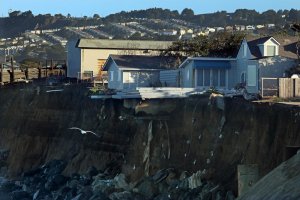The California coast grew and prospered during a remarkable moment in history when the sea was at its tamest.
But the mighty Pacific, unbeknownst to all, was nearing its final years of a calm but unusual cycle that had lulled dreaming settlers into a false sense of endless summer.

Elsewhere, Miami has been drowning, Louisiana shrinking, North Carolina’s beaches disappearing like a time lapse with no ending. While other regions grappled with destructive waves and rising seas, the West Coast for decades was spared by a rare confluence of favorable winds and cooler water. This “sea level rise suppression,” as scientists call it, went largely undetected. Blinded from the consequences of a warming planet, Californians kept building right to the water’s edge.
But lines in the sand are meant to shift. In the last 100 years, the sea rose less than 9 inches in California. By the end of this century, the surge could be greater than 9 feet.
Red the full story on LATimes.com.
Everyone I met seemed to acknowledge the problem: The ocean is now rising higher and faster in California, but everything built before we knew better is fixed in place with nowhere to go. Pacific Coast Highway. Dream homes in Malibu. The surfliner… https://t.co/pR4yxMFKEJ
— Rosanna Xia (@RosannaXia) July 7, 2019






















